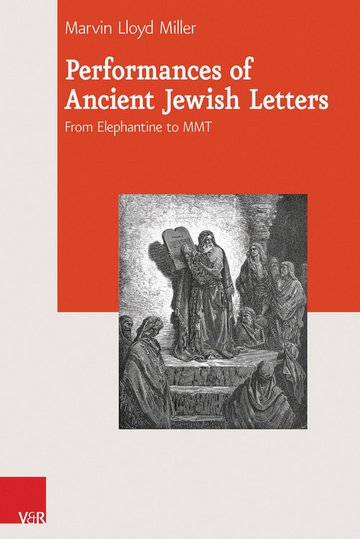| Cover | 1 |
| Title Page | 4 |
| Copyright | 5 |
| Table of Contents | 6 |
| Body | 10 |
| List of Abbreviations | 10 |
| Primary Literature | 10 |
| Secondary Literature | 11 |
| Preface | 16 |
| Chapter 1 Introduction | 18 |
| 1.1 Performance Criticism | 20 |
| 1.1.1 Different Approaches to Performance | 20 |
| 1.1.2 Towards a Definition of Performance Criticism | 26 |
| 1.2 Performance and Ethnopoetics | 28 |
| 1.3 Performance and Folklore | 30 |
| 1.4 New Directions | 35 |
| Chapter 2 Going Behind the Scenes: History of Scholarship | 38 |
| 2.1 History of Scholarship of Ancient Letters | 39 |
| 2.1.1 Greek Letters | 39 |
| 2.1.2 Aramaic Letters | 42 |
| 2.1.3 Hebrew Letters | 46 |
| 2.2 What is a Letter? | 50 |
| 2.3 History of Scholarship of MMT | 54 |
| 2.4 Observations | 57 |
| Chapter 3 Setting the Stage: Methods | 58 |
| 3.1 Contributions of Historical Critical Methods | 59 |
| 3.1.1 Form Criticism | 59 |
| 3.1.2 Redaction Criticism | 61 |
| 3.2 Contributions of Recent Insights into Texuality | 62 |
| 3.2.1 Semiotics | 62 |
| 3.2.2 Oral Processes | 66 |
| 3.3 Observations | 72 |
| Chapter 4 Preparing for the Performances | 74 |
| 4.1 From Text to Performance | 75 |
| 4.1.1 How to Read a Letter | 76 |
| 4.1.2 Letter Carriers and Readers | 82 |
| 4.2 Performances and Audiences | 84 |
| 4.2.1 Embodiment of a Text for an Audience | 85 |
| 4.2.2 Interaction with the Audience | 87 |
| 4.2.3 Authority of the Performer | 91 |
| 4.2.4 Performance and Cultural Memory | 94 |
| 4.3 Performance in Second Temple Judaism | 96 |
| 4.3.1 Some Scholarly Proposals for Jewish Scribal Traditions | 97 |
| 4.3.2 Performances of Ancient Jewish Letters | 99 |
| 4.3.3 Qumran Scribal Tradition | 101 |
| 4.4 Observations | 103 |
| Chapter 5 Performances of two Free Standing Letters from Egypt | 106 |
| 5.1 Form And Function Of Ancient Letters | 107 |
| 5.2 Hermopolis Family Letter | 110 |
| 5.2.1 Text | 111 |
| 5.2.2 Texture | 114 |
| 5.2.3 Context | 123 |
| 5.3 Passover Letter | 127 |
| 5.3.1 Text | 128 |
| 5.3.2 Texture | 130 |
| 5.3.3 Context | 138 |
| 5.4 Summarizing the Performances | 140 |
| Chapter 6 Performances of two Embedded Jewish Letters | 142 |
| 6.1 Aramaic Letters in Ezra: An Overview | 143 |
| 6.2 An Embedded Aramaic Letter: Ezra 5 | 146 |
| 6.2.1 Text | 146 |
| 6.2.2 Texture | 149 |
| 6.2.3 Context | 158 |
| 6.3 An Embedded Hebrew Letter: Jeremiah 29 | 161 |
| 6.3.1 Text | 162 |
| 6.3.2 Texture | 166 |
| 6.3.3 Context | 182 |
| 6.4 Summarizing the Performances | 186 |
| Chapter 7 Performances of two Greek Letters | 188 |
| 7.1 An Embedded Letter in Greek Esther | 189 |
| 7.1.1 Text | 190 |
| 7.1.2 Texture | 193 |
| 7.1.3 Context | 205 |
| 7.2 An Introductory Letter to 2 Maccabees | 207 |
| 7.2.1 Text | 207 |
| 7.2.2 Texture | 214 |
| 7.2.3 Context | 219 |
| 7.3 Summarizing the Performances | 220 |
| Chapter 8 A Case Study of the Performances of MMT | 222 |
| 8.1 Text | 223 |
| 8.1.1 Scene 1: Calendrical Section | 224 |
| 8.1.2 Scene 2: Legal Section | 226 |
| 8.1.3 Scene 3: Exhortation Section | 242 |
| 8.1.4 Evaluation of the evidence gathered from the text | 247 |
| 8.2 Texture | 248 |
| 8.2.1 Oral Register | 248 |
| 8.2.2 Cultural Traditions | 251 |
| 8.3 Context | 255 |
| 8.3.1 Late Second Century BCE Performances | 256 |
| 8.3.2 Late First Century BCE. Performance | 259 |
| 8.3.3 A Performance Reflecting on an Earlier Tradition | 261 |
| 8.4 Bringing the Performances Together | 264 |
| Chapter 9 Conclusions | 268 |
| Bibliography | 276 |
| Ancient Literature | 304 |
| Modern Authors | 310 |
| Subject | 316 |



















